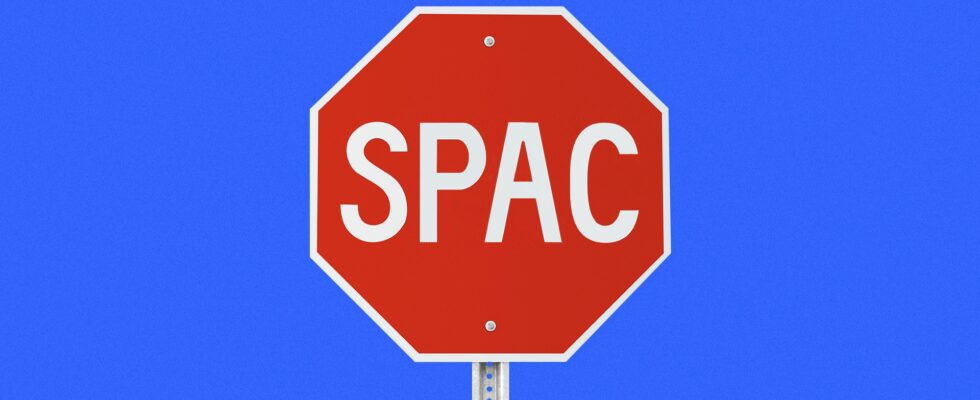(BFM Bourse) – According to a count conducted by the Bloomberg press agency, at least 21 former Spacs that acquired a company went bankrupt this year. Which, compared to the stock market peak of each of these companies, amounts to erasing a total of more than $46 billion in capitalization.
After the drunkenness, it’s time for a (severe) hangover for the Spac (“special purpose acquisition company”), these “blank check” companies.
Remember that these investment vehicles are formed without any activity and are listed on the stock market to raise funds with the aim of then acquiring one or more companies. These operations allow the companies thus acquired to rejoin the stock market while benefiting from lighter regulation.
In a period of low or even negative rates, Spacs have experienced real excitement, especially in 2021. According to the consulting company Kroll, no fewer than 613 Spacs were launched in 2021, for total fundraising of $163 billion. .
Alas, the Spac fashion has now passed or even been buried. In 2022, the number of Spacs created fell to 86 for fundraising of $13 billion, according to Kroll. As for 2023, in the first half alone, Spac creations fell by 76% to just 17, with $2 billion in funds raised.
Above all, several companies which merged with Spacs went out of business this year. According to a count published Wednesday by the Bloomberg agency, at least 21 ex-Spacs which therefore bought one or more companies went bankrupt in 2023. “Measured based on their maximum market capitalizations, these bankruptcies represent a loss of more than 46 billion dollars in total equity value,” the agency explains.
>> Access our exclusive graphic analyses, and gain insight into the Trading Portfolio
The decline of Wework and electric vehicles
The best-known case remains the company specializing in shared workspaces Wework. Introduced on the stock market in 2021 via a merger with Spac BowX, an operation already at a discount at the time compared to its initial ambitions, the American group went from Charybdis to Scylla, strangled by its debt and the high rents of its premises as well as by the widespread use of teleworking. The company, whose stock market peaked around $9.4 billion, filed for bankruptcy protection in November.
Beyond Wework, the bankruptcies of ex-Spacs this year highlight another trend: the end of the stock market hype around electric vehicles. Merged with Spac DiamondPeak Holdings in 2020, the American manufacturer of electric pick-ups Lordstown Motors went bankrupt this summer, abandoned by the Chinese group Foxconn which stopped its investments in the group. Lordstown had barely delivered 18 vehicles to its customers and produced 56 vehicles since its inception. Incidentally, the company was the subject of an investigation by the SEC, the American stock market watchdog, after being accused by Hindenburg Research, a very serious short seller, of having lied about its orders… not Tesla who wants.
The specialist in components for large electric vehicles (such as buses) Proterra had merged with Spac ArcLight Clean Transition in 2021 before going bankrupt last August, citing the economic situation. The Swedish Volvo, however, bought this company in November 2023 for $210 million.
Interest rate increases
Concerning the cascading bankruptcies of ex-Spacs which have acquired targets, Bloomberg notes that the companies acquired have tended to deliver much more optimistic projections than they would have been in a classic IPO process.
Quoted by Bloomberg, Usha Rodrigues, professor of law at the University of Georgia, believes that the enthusiasm generated by “meme stocks” and the promise of high valuations have encouraged unlisted companies to carry out mergers with Spacs at a fast pace. The result was a glut of Spacs that Usha Rodrigues describes as “a time bomb” of corporate bankruptcies that materialized in 2023.
The deflation of the bubble in terms of Spac creations can be explained by a set of elements, in particular a turn of the screw in terms of regulation occurring in 2022. The SEC then imposed more regulation on its well-known companies (and perhaps appreciated) for their lack of transparency. “Soon after, the Wall Street giants began to distance themselves from operations involving (these) blank check companies and the Spac reservoir dried up,” notes Bloomberg.
The rise in interest rates, making financing operations more expensive and therefore less easy while weakening company balance sheets, may also have had an impact on the end of this enthusiasm.
Remember that if a Spac does not find targets to buy back at an attractive price within a few dozen months (24 months for example), the money raised is returned to investors. In an environment of low or even negative rates, this does not pose a huge problem in terms of risks. But soaring interest rates have completely changed the situation. “Today, in order to attract investors, the promoters (of Spac, Editor’s note) are offering additional guarantees according to which, in the event of failure of the operation, they will return up to 2% more than the initial sum “, underlined EY last year.
Moreover, two well-known European SPACs had to cease their operations this year due to lack of acquisition. Pegasus Europe, the largest Spac on the Old Continent, was liquidated in the spring, returning its cash to investors after failing to find an interesting target for two years. The Accor hotel group’s Spac, Accor Acquisition Company, suffered the same fate in May, drawing the curtain two years after having raised 300 million euros without, however, finding targets corresponding to its criteria.
Julien Marion – ©2023 BFM Bourse
